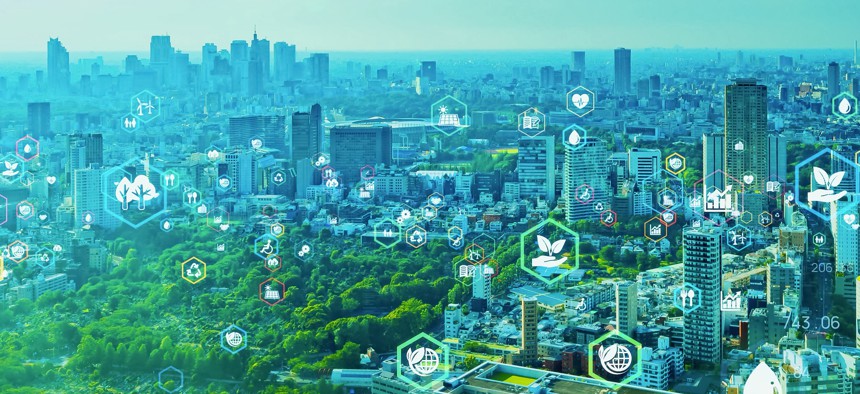Government tech – What’s sustainability got to do with it?

An IT sustainability guide from the GSA and CIO Council advises agencies to consider energy efficiency and environmental impact in their technology procurements. metamorworks / Getty Images
As it turns out, a lot, according to a recent best practices guide for agency CIO’s, and to Energy Department CIO Ann Dunkin.
As the Biden administration pushes the federal government to be more sustainable, one place to watch is the intersection of that goal with government IT.
“Technology is a huge contributor to climate change,” said Ann Dunkin, chief information officer at the Department of Energy. “From a sustainability standpoint, we’re looking at, ‘How can we make technology more sustainable?’”
She spoke with Nextgov/FCW recently about the role of the agency CIO following the release of an IT sustainability guide by the General Services Administration and CIO Council in March.
That guide, required by Congress in the Energy Act of 2020, is also meant to support agencies as they implement a 2021 executive order that set the goal for the federal government’s operations to have net-zero emissions by 2050.
Achieving that will require a move to zero-emission vehicles and energy-efficient buildings, among other things, the administration says. But the government’s tech also impacts the climate.
“An increased investment in IT sustainability presents a tremendous opportunity for the federal government to do more to… meet the White House’s high-level benchmarks,” the guide states.
The role of tech in the push to become more climate-friendly might not be getting the same level of public attention as moving to clean vehicles, for example, but Dunkin said that CIO’s are paying attention.
“Most of my CIO colleagues really care about this,” she said. And, “even if someone doesn’t give a crap about the environment, it saves money.
“So [from] the standpoint of a CIO, you're gonna drive towards solutions that are more efficient and cost effective,” said Dunkin. “Because that's the right thing to do for the environment [and] it's the right thing to do for your business.”
Big picture, “the manufacture of IT products has a significant impact on climate change, from the energy used to power the manufacturing facilities to the potent, long-lived greenhouse gases used and emitted during the manufacturing of LCD displays and semiconductors,” an EPA spokesperson told Nextgov/FCW in a statement.
The energy used to run tech also matters.
Data centers, for example, currently account for 2% of U.S. energy consumption — “10 to 50 times more energy than the average commercial building,” according to the recent best practices guide.
“Further adoption of cloud service providers and colocation facilities is a best practice that agencies should consider when operating their data centers,” the guide states.
Traditional data centers are big consumers of energy and water, and efficiencies in cloud computing can make them more sustainable.
Still, “while calling cloud adoption a ‘win’ for our environment is an appealing proposition, the reality is more complex,” the guide cautions. “Agencies need to ensure the move to the cloud is designed toward desired sustainability outcomes.”
“People say, ‘Everyone’s got to go to the cloud!’” said Dunkin. “But the challenge behind that is… how do you know your cloud provider is being environmentally sustainable?
“There are ways to save money that are not environmentally sustainable. For example, dirty energy is often cheaper than clean energy,” she explained.
Agencies should ask providers about things like where their power is sourced from and whether they use renewable energy, the guide states.
It also suggests requiring cloud service providers to report greenhouse gas emissions to not-for-profit Carbon Disclosure Project, and calls out the need for “increased transparency into the sustainability of platform-as-a-service and software-as-a-service companies and products” specifically.
The guide also offers considerations for how agencies should consider the balance of procuring new hardware versus maintaining legacy systems.
“Given the vast amount of energy and resources required to build, retire and/or recycle large-scale hardware assets, environmentally-conscious agencies should first consider the lifespan of these investment decisions,” the guide states.
“Technologies may be quickly outdated and labeled as ‘legacy’ hardware,” it continues. “While each case is unique, agencies should consider that the overall energy impact of maintaining legacy hardware may be less than the up-front energy cost of purchasing and installing new hardware assets.”
When agencies do purchase new hardware, the guide encourages them to go for energy efficiency, even if it costs more.
Even as tech can have negative impacts in terms of sustainability, Dunkin noted that it “also has the opportunity to do amazing things to help with the environment,” pointing to research and development at the Energy Department itself — in May, the department announced $40 million in funding for projects to develop cooling solutions for data centers, for example.
The best-practices guide also directs agencies to the use of virtual tech like edge computing that can be more sustainable, as well as the things CIO’s should look to in their business functions. That includes integrating IT sustainability into agency strategic planning and increasing communication between sustainability and tech teams.
“In reviewing agency sustainability plans, many agencies focused heavily on facility efficiency goals. While facilities are an important piece of an agency’s sustainable outcomes, they are not the complete picture. Many sustainability plans lack focus on tangible technologies and the use of these technologies to meet sustainability goals,” the guide states.
“IT is a much-needed tool for agencies to meet sustainability goals,” it says. “Without emerging technologies and well-planned architectures and infrastructure, sustainability goals will be impossible to reach.”






